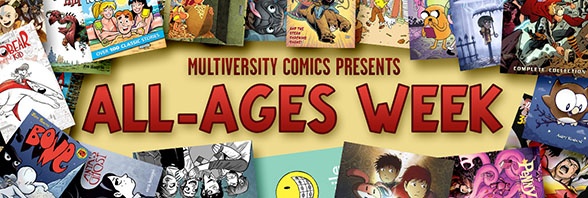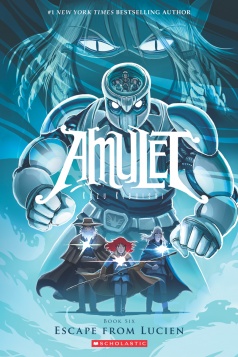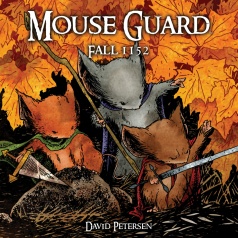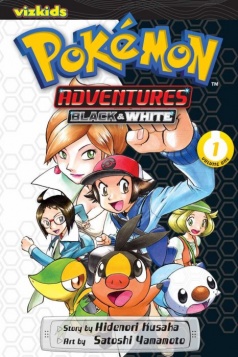
So far in All-Ages Week, we’ve talked about many of the ways kids and teens can acquire comic books. Amongst the most common ways are at comic shops, bookstores or at home on a phone or tablet, and those are enormously valuable in the overall mix for comics. But one element we haven’t talked about yet is a huge one that often gets forgotten in discussions like this: libraries.
Whether you’re talking about a public library or school library, these places are bastions of literacy of all varieties, and they help stoke the flames of interest in reading in young people. They’re important institutions, and for both comic readers and pundits, they’re often strangely forgotten. They can help sculpt the readers of tomorrow in ways that few other places can, with readily available librarians there to help guide neophyte readers to their new favorite comic, while giving them access to diverse collections at the perfect rate for any young person: free.
Libraries and the librarians that work within them deserve the spotlight for what they do to ensure that kids learn to love to read – not just comics, but anything – and we’re going to give them that. Today, we’re going to look into the value they bring to the table and the role they play in all-ages comics with the help of top comic creators, key people at publishers, and an array of the champions of comics and graphic novels from libraries across the country. Hopefully this will help remind you why kids around the country love their local library, and why you should too.
Comics, Libraries and a Mutually Beneficial Relationship
Libraries have long carried comics and graphic novels, but the relationship between the two has seen a significant shift in recent years, at least in the minds of the people I spoke with.
“Since they discovered graphic novels, it’s been wonderful,” shared Chris Staros of Top Shelf. “Early on, when libraries had just started to pick up graphic novels – I think it was around 2000 when they considered putting in graphic novels – all-ages ones were the easiest for them to put in.”

It’s easy to see why. After all, they provide a lot of value for readers of all ages in both forging literacy and creating an affinity for reading.
“Comics are a key piece of literacy,” Chris Shoemaker, the President of the Young Adult Library Services Association (YALSA) said. “They meet both the traditional sort of reading literacy but also help with critical literacy skills, because there are facial expressions that teens interpret as part of their understanding of the panels and emotional indicators especially in manga that provide those points and references. Just because comics have pictures and are picture heavy in their narrative, doesn’t mean they don’t foster and help encourage literacy skills in any way shape or form.”
Kat Kan, a long-time comic advocate and librarian at the St. John Catholic School in Panama City, Florida, agrees with that sentiment.
“Graphic novels are just another format of literature. The mix of art and text helps to exercise readers’ minds, and the format does lend itself to making reading less scary for those who are reluctant readers,” she said. “Anything that helps kids think of reading as a fun activity and not just something they have to do for school is going to keep these kids reading, and the more they read for fun, the better off they are in life.”
In the minds of many librarians, a lot of the value of comics comes from that last idea she shared. Many young (and older) people look at reading as a chore, and something that more closely resembles work than something they enjoy. But comics can deliver an experience that cuts right through that, giving those who struggle with reading or simply don’t enjoy it another avenue to take in a written narrative and still get a mental workout. And libraries are a perfect place for younger readers to get access to comics at for a number of reasons.
Continued below“I think a really big one is you can explore,” Baur said. “Kind of the whole reason of being here is to create those opportunities where people can just kind of browse and give things a try. Whenever anyone is uncertain about checking something out from the library, I’m like, ‘what do you lose if you take this home and it sucks?’ Nothing! Nothing at all, as long as you’re not late.”
Being able to borrow comics in such a way has helped the medium reach new readers, and the nature of libraries have also helped some of the most popular comics go viral among young readers, expanding that reach even further.
“In the library it’s easier to talk about and share with friends and other students about the comics you are reading,” Shoemaker said. “It’s easier to go in there and pull something off the shelf and be like, ‘I love this. I hope that you enjoy it.’ Libraries can help facilitate lending and borrowing of comics.”
Kazu Kibuishi, the cartoonist behind the all-ages comic sensation “Amulet”, strongly agreed with that idea, and the idea that being able to reread through the library helps solidify a story’s impact.

Another important reason is what librarians themselves bring to the table, as they help cut through the confusion questions like “where do I start?” and “what should I read?” bring to readers minds.
“Libraries offer knowledgeable people who are deeply invested in the stuff that they have, and want to share,” Baur said. “The kids here, one of the main things they have here is me. I want to engage them in the things they are interested in, and want to hear about the things they like and why. I want to have a collection that reflects those interests, but also expands those interests. I want to be here to talk with them about it.”
What people like Baur, Kan and Shoemaker do as librarians does not go unnoticed by those around the industry, as Beth Kawasaki of Viz Media shared.
“Librarians were always ahead of the curve and continue to be some of the best advocates for manga and comics. What better way to get a kid into reading than through sequential art? For kids who don’t read, there are wordless comics. For kids who have difficulty reading prose, there are pictures. For kids who don’t like reading, hey, there’s a book with your favorite TV or video game character.”
“I can’t tell you how much we truly appreciate librarians.”
“The great thing about librarians is that they just want people to read books. Not certain kinds of books. Just books,” Jennifer de Guzman, Director of Trade Book Sales at Image, said. “Their goal is to meet their patrons’ needs. If the only book that’s going to get a kid — or an adult reader, for that matter — reading is a comic book, they’re going to give that person a comic book.”
Gina Gagliano of First Second Books highlighted another key attribute of libraries when it comes to young people trying out comics.
“They’re a wonderful resource for people without a lot of money to have access to books and reading,” she said, before adding, “Kids and teenagers are a big component of the ‘people without a lot of money’ demographic!”
That’s one of the most underrated elements of libraries, at least in my mind. Much ado has been made about how comics are pricing out kids, but this demographic can get access to a whole world of titles with little more than a library card needed. Beyond that, some kids live in areas that don’t have easy access to comics in any other way, and libraries provide an effective way to get access to them, as Scholastic/Graphix’s David Saylor said.
Continued below“They were the first to offer a selection of graphic novels appropriate for kids and to make them available, since many kids aren’t near a comics store or even a bookstore.”
That’s a story I’ve heard several times from people I’ve spoken to about libraries and comics. Some people grow up in rural areas or areas that simply don’t have a comic shop or a bookstore that carries comics, and save for digital, a library is the only place that can help turn that young person into a fan of the medium.
The digital angle was one that libraries encourage as well, which was a surprise.
“One of the ways that libraries have actually increased access to comics even more is by the internet access we provide for students and teens who might not have high speed Internet access at home, or might only be accessing it via a small mobile device,” Shoemaker shared. “Digital comics are a great fit with libraries and the Internet access we provide.”
How Libraries Have Helped Create a Healthier Comic Industry
For all those reasons, libraries are hugely important to kids, and because of that, they’ve become beloved pillars of the comics community in the minds of creators and publishers alike.
“Librarians have been essential,” said Raina Telgemeier, the cartoonist behind the enormously popular biocomics “Sisters” and “Smile.” “I can’t stress their importance enough. Graphic novels have exploded in libraries, and the demand for what we do has grown because librarians want more books on their shelves for their voracious readers.”
Saylor agreed with that, saying, “I think Libraries (both public and school libraries) have been instrumental in supporting the expansion of the graphic novel market. Librarians have been at the forefront of promoting and championing graphic novels for kids. And they still are.”

“When a librarian can recommend or support a book like Mouse Guard, folks listen to that as a solid suggestion from an authority,” Petersen said. “And taking a book about walking, talking mice with swords and validating it to skeptics – some who write it off as ‘just for kids’ or ‘too violent for kids’ or ‘fluff’ – is a huge help to me from a community who loves seeing people interested in books.”
But that works both ways, as the comic industry has to do its part to help separate the signal from the noise when it comes to what works for young readers and what doesn’t, and sometimes, it helps for publishers to guide them.
“We support them in many ways: by interacting at conferences, sending authors out to speak, and by creating a brochure, when we launched Graphix, offering guidance on how to use comics in classrooms and libraries – we’ll be offering an updated version of this guide in 2015,” Saylor shared.
The latter idea – the teaching guide – is one that was mentioned multiple times by both publishers and librarians of one of real importance.

Beyond that, de Guzman shared other ways they inform libraries about their work, including making advance review PDF’s of trades and graphic novels available before release.
“Being visible and available to librarians is essential,” she said. “I send out a newsletter twice a month with the latest information about our books, with links to reviews of Image books at publications that librarians trust, like Library Journal or Publishers Weekly, and articles in the mainstream media that show them what their patrons might becoming aware of and interested in.”
Conversely, Baur does what he can to help educate librarians, whether that means through the “Who’s Afraid of Comic Books?” presentations he puts together with frequent collaborator (and fellow librarian) Amanda Jacobs Foust and the Tumblr/podcast he runs with Foust called “In the Library with a Comic Book” to help educate librarians on what comics they should be excited about. Through that all, he believes librarians are learning a lot, but it’s time to step it up.
Continued below“People don’t need graphic novels 101 anymore. Now it’s time for 201,” he said. “We have these collections. We know what to do with them. How do we keep developing them? How do we stay on top of them and what kind of opportunities does having these materials open up for us, in terms of outreach, programming and diversifying our education and reaching other types of readers?”
Shoemaker and YALSA have done their part as well.
“We have done a couple of webinars in the past for members looking for collection development advice and things like that. We also have the YALSA hub blog that updates regularly, and they cover graphic novels on an infrequent basis, and we have the Great Graphic Novels for Teens list,” Shoemaker said. “Those are the three main ways to do education, but we also have our yearly symposium that focuses on all aspects of teen services, and we’d welcome a presenter who would want to do an educational panel on graphic novels.”
Libraries and Making the Comic Readers of Tomorrow
Through libraries, kids are reading comics every day. They’re helping creators like Telgemeier, Kibuishi and Petersen reach kids they may never have reached otherwise. They’ve helped publishers like Scholastic/Graphix, Viz, Image and Top Shelf find new readers who form the foundation of their audience. And they’re helping diversify what kids are reading within that. Manga and youth oriented graphic novels are enormously popular at libraries, according to the librarians we spoke to, that has helped dramatically increase their reach.
“I think initially it was our manga collections that were the most popular. They had the biggest run and most access through Viz and Tokyopop,” Shoemaker said, before adding, “And now, it’s more of those transition novels of what would have once been a traditional print narrative has now been turned into a graphic narration. Those are becoming more popular. The market hasn’t exploded the same way as it did for manga. That trend will likely continue to grow. It’s on its upswing now.”
Kan went further still, citing a wide breadth of genres and topics that kids at her school are actively interested in.

It’s interesting that within my discussions, Marvel and DC almost never came up, but Kan shared part of why that might be: “Most of what Marvel and DC publish is not suitable for my school library.”
Whatever kids want to read, though, is working when it comes to libraries. A big part of that is what de Guzman said was a key at libraries – “The message of libraries is that reading is reading” – and it provides kids a safe place to let their imaginations run wild and to learn what interests them as young readers. Whether that means comics, prose, picture books, or anything else doesn’t matter. It’s the reading that matters, and the passion that comes with it.
Libraries are the fires where that passion is forged, and they’re monumental in helping comics succeed both today and tomorrow, which in the minds of people like de Guzman makes them something that are hugely important for the comic industry to embrace as they try to reach young readers.
“I love the idea of a kid being able to go to the library and find a book they really get excited about. The books that you read as a kid shape your tastes for the rest of your life. If kids can go to their library and find out that they love comics, then they’ll probably keep loving comics. If a little girl goes to a library and finds and loves ‘Oddly Normal’, in ten, fifteen years, she might discover and love something like ‘Pretty Deadly.’ If a kid who is having trouble reading picks up a comic and learns to enjoy reading because of it, he’s going to remember that. It’s a long-term investment.”
“It’s making new comics readers.”






